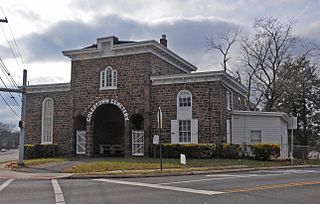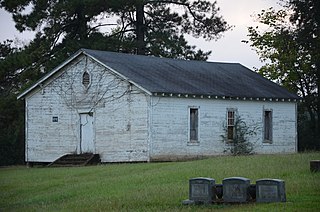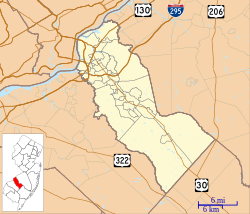
Camden County is a county located in the U.S. state of New Jersey. Its county seat is Camden. As of the 2020 census, the county was the state's ninth-most populous county, with a population of 523,485, its highest decennial count ever and an increase of 9,828 (+1.9%) from the 2010 census count of 513,657, which in turn reflected an increase of 4,725 (0.9%) from the 508,932 counted in the 2000 census. The county is part of the South Jersey region of the state.

Blackwood is an unincorporated community and census-designated place (CDP) located within Gloucester Township, in Camden County, in the U.S. state of New Jersey. As of the 2010 United States census, Blackwood's population was 4,545. It is located 10 miles (16 km) from the city of Camden and 14.6 miles (23.5 km) away from Philadelphia in the South Jersey region of the state.

Gloucester Township is a township in Camden County in the U.S. state of New Jersey. As of the 2020 United States census, the township was the state's 22nd-most-populous municipality, with a population was 66,034, an increase of 1,400 (+2.2%) from the 2010 census count of 64,634, which in turn reflected an increase of 284 (+0.4%) from the 64,350 counted in the 2000 census. The township had been ranked as the 19th-most populous municipality in the state in 2010 after having been ranked 18th in 2000.

Waterford Township is a township in Camden County, in the U.S. state of New Jersey. As of the 2020 United States census, the township's population was 10,421, a decrease of 228 (−2.1%) from the 2010 census count of 10,649, which in turn reflected an increase of 155 (+1.5%) from the 10,494 counted in the 2000 census.

Winslow Township is a township in Camden County, in the U.S. state of New Jersey. As of the 2020 United States census, the township's population was 39,907, an increase of 408 (+1.0%) from the 2010 census count of 39,499, which in turn reflected an increase of 4,888 (+14.1%) from the 34,611 counted in the 2000 census.

Woolwich Township is a township within Gloucester County in the U.S. state of New Jersey, within the Philadelphia metropolitan area. As of the 2020 United States census, the township's population was 12,577, its highest decennial count ever and an increase of 2,377 (+23.3%) from the 2010 census count of 10,200, which in turn reflected an increase of 7,168 (+236.4%) from the 3,032 counted in the 2000 census. Woolwich Township and surrounding Gloucester County constitute part of South Jersey.

Route 168 is a 10.7-mile (17.22 km) state highway in the southern part of New Jersey. The route's southern terminus is an interchange with Route 42 and the Atlantic City Expressway in the Turnersville section of Washington Township, Gloucester County. The northern terminus is an intersection of Ferry Avenue on the border of Camden and Woodlynne in Camden County. At this point, the route continues toward Downtown Camden as Mt Ephraim Avenue. Route 168 follows the Black Horse Pike for most of its length, running through suburban areas in Gloucester Township, Runnemede, Bellmawr, and Mount Ephraim. It intersects and interchanges many major roads, including the Route 42 freeway in Gloucester Township, Route 41 in Runnemede, the New Jersey Turnpike and I-295 in Bellmawr, Route 76C in Haddon Township, and US 130 in Camden.

The Cold Spring Presbyterian Church is a Presbyterian church in Cold Spring, New Jersey, founded in 1714.

The Gabreil Daveis Tavern House, also known as the Hillman Hospital House, is a historic building in the Glendora section of Gloucester Township, Camden County, New Jersey, United States. This tavern was built in 1756 near the Big Timber Creek and housed boatmen who used the creek to ship goods to Philadelphia. It was designated a hospital by George Washington during the Revolutionary War.

The Chew–Powell House is located at 500–502 Good Intent Road in the Blenheim section of Gloucester Township in Camden County, New Jersey, United States. The historic house was built in 1688 by James Whitall. The Chew–Powell–Wallens Burying Ground, next to the house, is considered to be the oldest cemetery in the township, and it reportedly contains the remains of early settlers, soldiers of the Revolutionary and Civil Wars and Leni Lenape Native Americans.

Glendale Methodist Episcopal Church is a historic church at 615 Haddonfield-Berlin Road, at the junction with White Horse Road, in the Glendale section of Voorhees Township, Camden County, New Jersey, United States. It was added to the National Register of Historic Places on August 4, 1995, for its significance in community planning, development, and education from 1855 to 1920. At the time of its construction, the village of Glendale was impacted by the train station stop of Ashland on the Camden Atlantic Railroad. Because of the railroad, Philadelphians and shore villagers came to trade and do business.

Bethel African Methodist Episcopal Church is a historic African Methodist Episcopal Church in Springtown, New Jersey, United States. The church was part of two free negro communities, Othello and Springtown, established by local Quaker families, like the Van Leer Family. The congregation was established in 1810 in Greenwich Township as the African Methodist Society and joined the African Methodist Episcopal Church in 1817. A previous church building was burned down in the 1830s in an arson incident and the current structure was built between 1838 and 1841.

Mount Zion African Methodist Episcopal Church and Mount Zion Cemetery is a historic church and cemetery located at 172 Garwin Road in Woolwich Township, New Jersey, United States. The church was a stop on the Greenwich Line of the Underground Railroad through South Jersey operated by Harriet Tubman for 10 years. The church provided supplies and shelter to runaway slaves on their way to Canada from the South. The church and cemetery were part of the early 19th-century free negro settlement sponsored by Quakers known as Small Gloucester.

The Richwood Methodist Church is located at 104 Richwood Road in the Richwood section of the township of Harrison in Gloucester County, New Jersey, United States. The historic church was built around 1860 and added to the National Register of Historic Places on January 19, 1979, for its significance in architecture. The listing includes the adjacent church cemetery.

The Gatehouse at Colestown Cemetery is located at the intersection of Kings Highway and Church Road in the township of Cherry Hill in Camden County, New Jersey, United States. The gatehouse was built in 1858 for the Colestown Cemetery. It was added to the National Register of Historic Places on May 21, 1975, for its significance in social history.

Moscow Methodist Church and Cemetery is a historic landmark built in 1864 and added to the National Register in 2006. The former community of Moscow is located just outside the current city limits of Prescott, Arkansas. The area is on or near the old "Moscow-Camden Road", or "Wire Road" which ran between Moscow and Camden, Arkansas. As of 2016, the location was known as the junction of Nevada County Roads 23 and 260.

The Whitehouse–Mechanicsville Historic District is a historic district located along old New Jersey Route 28, Mill, Lamington and School Roads in Whitehouse and Mechanicsville, unincorporated communities in Readington Township, Hunterdon County, New Jersey. It was added to the National Register of Historic Places on March 17, 2015 for its significance in architecture and community development. The district includes 140 contributing buildings.

Old Bridge, also known as the Historic Village of Old Bridge, is an unincorporated community located within East Brunswick in Middlesex County, in the U.S. state of New Jersey. It is on the South River, a tributary of the Raritan River. The community is named after the first bridge built here to cross the river, the South River Bridge. After other bridges were built crossing the river, it became known as the Old Bridge. The Old Bridge Historic District, encompassing much of the village, is listed on the state and national registers of historic places.




















